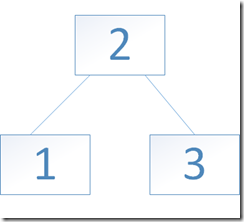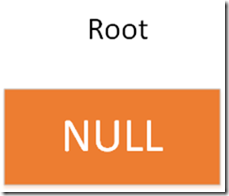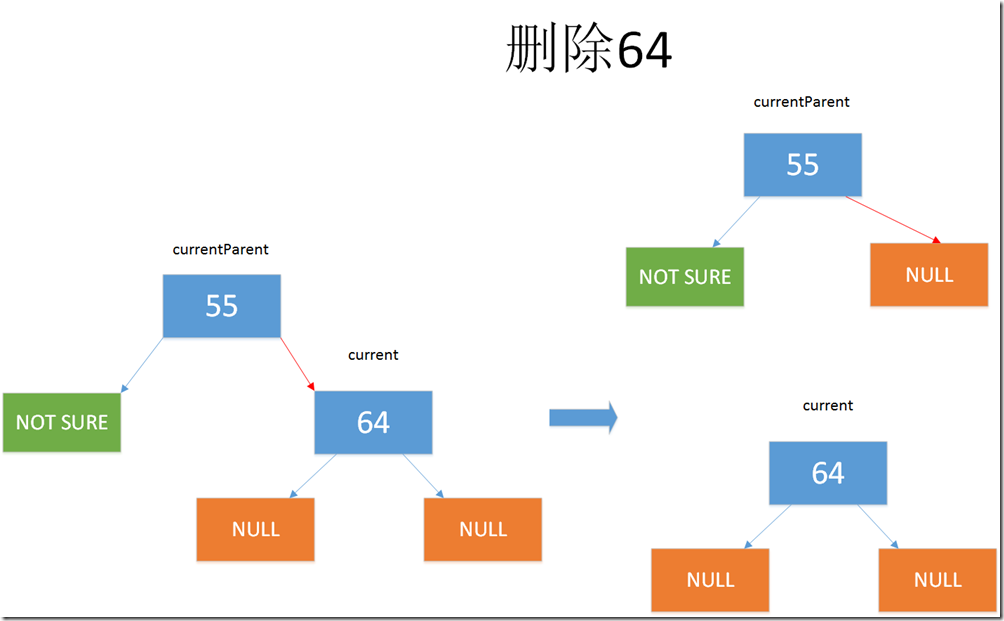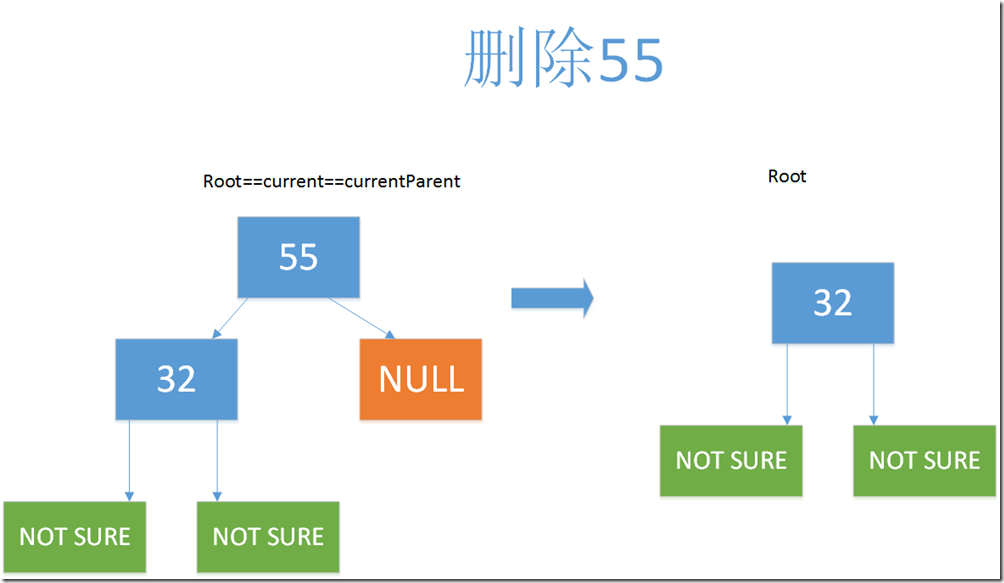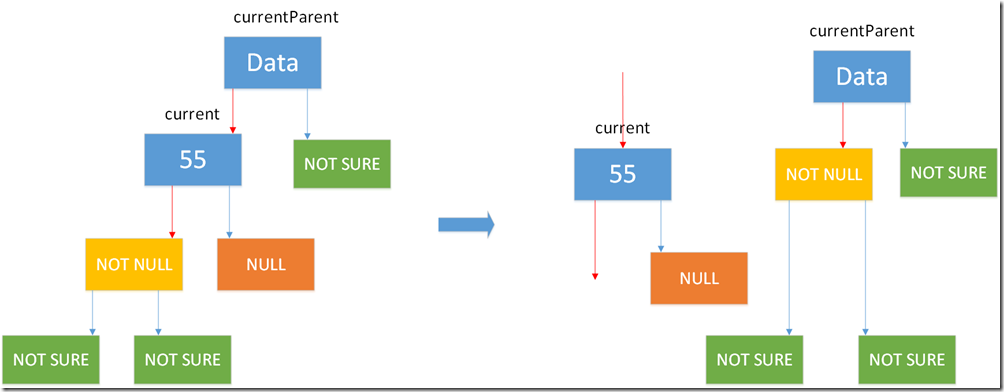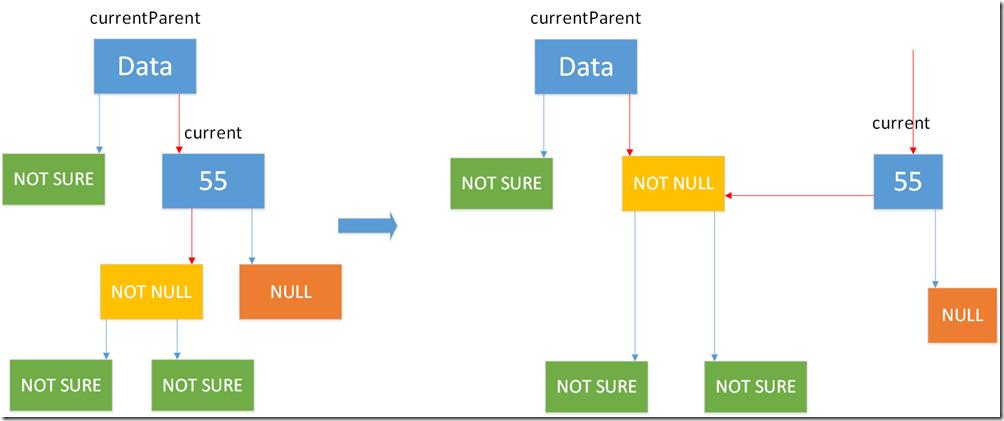二叉树和二叉查找树 代码分析
2012-11-10 23:29 gitenius 阅读(571) 评论(2) 编辑 收藏 举报在计算机科学中,二叉树是每个结点最多有两个子树的有序树。(http://baike.baidu.com/view/88806.htm)
二叉树的数据结构:
class Node declaration:
internal class Node { public int Data { get; set; } public Node Left { get; set; } public Node Right { get; set; } }
二叉树的基本操作:
Interface IBinarySearch declaration:
interface IBinarySearchTree { void Insert(int i); int? FindMin(); int? FindMax(); Node Find(int key); void PreOrder(Node node); void InOrder(Node node); void PostOrder(Node node); bool Delete(int key); }
二叉树方法源代码分析:
插入方法:用于构造二叉树。
public void Insert(int key) { // 创建新结点 Node newNode = new Node() { Data = key, Left = null, Right = null }; // 二叉树为空,则新结点为根结点 if (Root == null) { Root = newNode; } else // 二叉树非空 { Node current = Root; Node parent; while (true) { parent = current; if (current.Data < key) // 向右子树遍历 { current = current.Right; if (current == null) // 找到目标结点,插入,跳出循环 { parent.Right = newNode; break; } } else // 向左子树遍历 { current = current.Left; if (current == null) // 找到目标结点,插入,跳出循环 { parent.Left = newNode; break; } } } } }
找最小值:因为left < parent ,所以只需要从Root结点向左子结点遍历
public int? FindMin() { // 树为空时返回null if (Root == null) { return null; } // 树为非空,返回int Node current = Root; while (current.Left != null) { current = current.Left; } return current.Data; }
找最大值:因为lparent < right,所以只需要从Root结点向右子结点遍历
public int? FindMax() { // 树为空时返回null if (Root == null) { return null; } // 树为非空,返回int Node current = Root; while (current.Right != null) { current = current.Right; } return current.Data; }
查找结点:从根结点开始,根据Data与Key的比较
1.Data< key ,遍历右子树
2.Data>key,遍历左子树
3.Data==Key,找到值为key的结点,返回
public Node Find(int key) { Node current = Root; while (true) { if (current == null) { return null; // 未找到结点 } if (key < current.Data) // 遍历左子树 { current = current.Left; } else if (key > current.Data) // 遍历右子树 { current = current.Right; } else // 找到结点 { return current; } } }
先序遍历:首先访问根结点然后遍历左子树,最后遍历右子树。在遍历左、右子树时,仍然先访问根结点,然后遍历左子树,最后遍历右子树,如果二叉树为空则返回。采用递归的思想。
public void PreOrder(Node node) { if (node != null) { Debug.Write(node.Data.ToString() + " "); // 访问当前结点 PreOrder(node.Left); // 遍历左子树 PreOrder(node.Right); // 遍历右子树 } }
中序遍历:首先遍历左子树,然后访问根结点,最后遍历右子树。在遍历左、右子树时,仍然先遍历左子树,再访问根结点,最后遍历右子树。采用递归的思想。
public void InOrder(Node node) { if (node != null) { InOrder(node.Left); // 遍历左子树 Debug.Write(node.Data.ToString() + " "); // 访问当前结点 InOrder(node.Right); // 遍历右子树 } }
后序遍历:在访问根结点、遍历左子树与遍历右子树三者中,首先遍历左子树,然后遍历右子树,最后遍历访问根结点,在遍历左、右子树时,仍然先遍历左子树,然后遍历右子树,最后遍历根结点。采用递归的思想。
public void PostOrder(Node node) { if (node != null) { PostOrder(node.Left); // 遍历左子树 PostOrder(node.Right); // 遍历右子树 Debug.Write(node.Data.ToString() + " "); // 访问当前结点 } }
删除结点:如果结点存在,则删除,返回true;否则返回false;
结点表示方法:
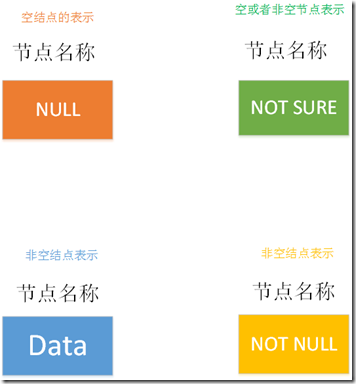
删除结点分为多种情况,下面逐一讨论:
1.二叉树为空树,返回false
if (Root == null) // 二叉树为空 { return false; }
if (current == null) { return false; // 未找到值为key的结点 }
3.删除叶子结点(没有子树)
if (current.Left == null && current.Right == null) { /* * 注意: * current.Left == null * current.Right == null */ if (current == Root) { Root = null; // 情况一 } else { if (isLeft) { currentParent.Left = null; //情况二 } else { currentParent.Right = null; //情况三 } } }
4.删除仅有左子树的结点(一棵子树)
else if (current.Left != null && current.Right == null) { /* * 注意: * current.Left != null * current.Right == null */ if (current == Root) { Root = current.Left;// 情况一 } else { if (isLeft) { currentParent.Left = current.Left;//情况二 } else { currentParent.Right = current.Left;//情况三 } } }
/// <summary> /// 获取删除结点的后继结点 /// 调整后继结点的左右子树 /// </summary> /// <param name="delNode"></param> /// <returns></returns> private Node GetSuccessor(Node delNode) { Node successorParent = delNode; // 后继结点的父结点 Node successor = null; // 后继结点 Node current = delNode.Right; // current 此时非空 while (current.Left != null) { successorParent = current; current = current.Left; if (current != null && current.Left == null) { break;// 找到delNode右子树的后继结点,跳出循环 } } if (successorParent == delNode) // delNode.Right 是后继结点,即del.Right.Left=null { successor = successorParent.Right; successor.Left = successorParent.Left; } else { successor = successorParent.Left; successorParent.Left = successor.Right; successor.Right = delNode.Right; successor.Left = delNode.Left; } return successor; }
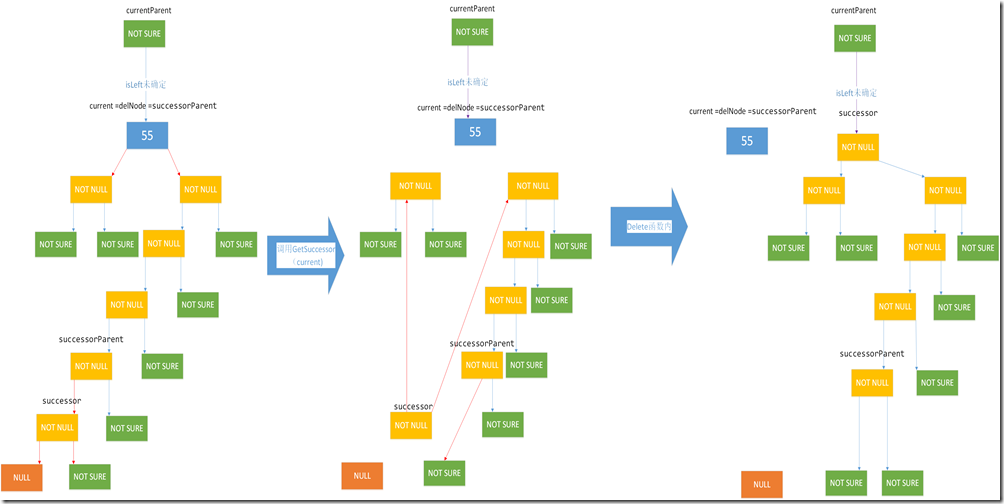
else if (current.Left != null && current.Right != null) { /* * 注意: * current.Left != null * current.Right != null */ var successor = GetSuccessor(current); if (current == Root) { Root = successor; } else { if (isLeft) { currentParent.Left = successor; } else { currentParent.Right = successor; } } }
Delete方法完整源码:
public bool Delete(int key) { if (Root == null) // 二叉树为空 { return false; } /* * 注意: * Root != null */ Node currentParent = Root; Node current = Root; bool isLeft = true; // 表示current结点时候为currentParent的左子结点 while (current.Data != key) { currentParent = current; if (key < current.Data) { isLeft = true; // current结点为currentParent的左子结点 current = current.Left; } else if (key > current.Data) { isLeft = false; // current结点为currentParent的右子结点 current = current.Right; } if (current == null) { return false; // 未找到值为key的结点 } } if (current.Left == null && current.Right == null) { /* * 注意: * current.Left == null * current.Right == null */ if (current == Root) { Root = null; } else { if (isLeft) { currentParent.Left = null; } else { currentParent.Right = null; } } } else if (current.Left != null && current.Right == null) { /* * 注意: * current.Left != null * current.Right == null */ if (current == Root) { Root = current.Left; } else { if (isLeft) { currentParent.Left = current.Left; } else { currentParent.Right = current.Left; } } } else if (current.Left == null && current.Right != null) { /* * 注意: * current.Left == null * current.Right != null */ if (current == Root) { Root = current.Right; } else { if (isLeft) { currentParent.Left = current.Right; } else { currentParent.Right = current.Right; } } } else if (current.Left != null && current.Right != null) { /* * 注意: * current.Left != null * current.Right != null */ var successor = GetSuccessor(current); if (current == Root) { Root = successor; } else { if (isLeft) { currentParent.Left = successor; } else { currentParent.Right = successor; } } } return true; }
二叉树的UnitTest:
Initialize()方法构造二叉树,具体测试内容见TestAll()方法的注释。</>
[TestClass] public class BinarySearchTree_Test { private BinarySearchTree _tree = new BinarySearchTree(); [TestInitialize] public void Initialize() { DebugMessage.WriteLineMsg("Initialize() Start :\\n"); StringBuilder builder = new StringBuilder(); //var items = RandomProducer(10); //items.Add(30); //items.Add(40); //items.Add(50); //items.Add(60); var items = new List<int> { 50, 20, 90, 10, 40, 88, 94, 30, 45, 80, 89, 96, 34, 76, 83, 98, 81, 84, 82 }; builder.Append("The List is :"); foreach (var item in items) { Insert_Test(item); builder.Append(item + " "); } DebugMessage.WriteLineMsg(builder.ToString()); ShowTree(); } /// <summary> /// 在50, 20, 90, 10, 40, 88, 94, 30, 45, 80, 89, 96, 34, 76, 83, 98, 81, 84, 82构成的二叉树中 /// 查找最小值,最大值 /// /// 查询50,80,1000 /// /// 先序遍历,中序遍历,后序遍历 /// /// 删除10(不包含子树) /// 删除30(仅包含右子树) /// 删除80(包含左右子树) /// 删除90(包含左右子树) /// </summary> [TestMethod] public void TestAll() { FindMin_Test(); FindMax_Test(); Find_Test(50); Find_Test(80); Find_Test(1000); PreOrder_Test(); InOrder_Test(); PostOrder_Test(); Debug.WriteLine("\n\n"); Delete_Test(10); Delete_Test(30); Delete_Test(80); Delete_Test(90); } [TestMethod] public void Insert_Test(int key) { _tree.Insert(key); } [TestMethod] public void FindMin_Test() { var min = _tree.FindMin(); DebugMessage.WriteLineIfMsg(min != null, String.Format("Min : {0}", min.Value)); } [TestMethod] public void FindMax_Test() { var max = _tree.FindMax(); DebugMessage.WriteLineIfMsg(max != null, String.Format("Max : {0}", max.Value)); } [TestMethod] public void Find_Test(int key) { var node = _tree.Find(key); DebugMessage.WriteLineMsg(node == null ? String.Format("Can't find {0} in the tree", key) : String.Format("Find {0} in the tree", key)); } [TestMethod] public void PreOrder_Test() { DebugMessage.WriteMsg("\nPreOrder :"); _tree.PreOrder(_tree.Root); } [TestMethod] public void InOrder_Test() { DebugMessage.WriteMsg("\nInOrder :"); _tree.InOrder(_tree.Root); } [TestMethod] public void PostOrder_Test() { DebugMessage.WriteMsg("\nPostOrder :"); _tree.PostOrder(_tree.Root); } [TestMethod] public void Delete_Test(int key) { DebugMessage.WriteLineMsg("Delete " + key); _tree.Delete(key); ShowTree(); } /// <summary> /// 遍历输出二叉树结构 /// </summary> private void ShowTree() { if (_tree.Root == null) { return; } DebugMessage.WriteLineMsg("\nRoot :" + _tree.Root.Data.ToString()); Show(_tree.Root); DebugMessage.WriteEndMsg(); } private void Show(Node current) { if (current == null) { return; } StringBuilder builder = new StringBuilder(); builder.Append("Parent : " + current.Data + " "); if (current.Left != null) { builder.Append("Left : " + current.Left.Data + " "); } if (current.Right != null) { builder.Append("Right : " + current.Right.Data + " "); } DebugMessage.WriteLineMsg(builder.ToString()); if (current.Left != null) { Show(current.Left); } if (current.Right != null) { Show(current.Right); } } /// <summary> /// 产生counter个随机数 /// </summary> /// <param name="counter"></param> /// <returns></returns> private IList<int> RandomProducer(int counter) { var lists = new List<int>(); Random rnd = new Random(Guid.NewGuid().GetHashCode()); for (int index = 0; index < counter; index++) { int item = rnd.Next(0, 100); lists.Add(item); } return lists; } }
测试结果:</>
Initialize() Start :\n
The List is :50 20 90 10 40 88 94 30 45 80 89 96 34 76 83 98 81 84 82
Root :50
Parent : 50 Left : 20 Right : 90
Parent : 20 Left : 10 Right : 40
Parent : 10
Parent : 40 Left : 30 Right : 45
Parent : 30 Right : 34
Parent : 34
Parent : 45
Parent : 90 Left : 88 Right : 94
Parent : 88 Left : 80 Right : 89
Parent : 80 Left : 76 Right : 83
Parent : 76
Parent : 83 Left : 81 Right : 84
Parent : 81 Right : 82
Parent : 82
Parent : 84
Parent : 89
Parent : 94 Right : 96
Parent : 96 Right : 98
Parent : 98
*********
Min : 10
Max : 98
Find 50 in the tree
Find 80 in the tree
Can't find 1000 in the tree
PreOrder :50 20 10 40 30 34 45 90 88 80 76 83 81 82 84 89 94 96 98
InOrder :10 20 30 34 40 45 50 76 80 81 82 83 84 88 89 90 94 96 98
PostOrder :10 34 30 45 40 20 76 82 81 84 83 80 89 88 98 96 94 90 50
Delete 10
Root :50
Parent : 50 Left : 20 Right : 90
Parent : 20 Right : 40
Parent : 40 Left : 30 Right : 45
Parent : 30 Right : 34
Parent : 34
Parent : 45
Parent : 90 Left : 88 Right : 94
Parent : 88 Left : 80 Right : 89
Parent : 80 Left : 76 Right : 83
Parent : 76
Parent : 83 Left : 81 Right : 84
Parent : 81 Right : 82
Parent : 82
Parent : 84
Parent : 89
Parent : 94 Right : 96
Parent : 96 Right : 98
Parent : 98
*********
Delete 30
Root :50
Parent : 50 Left : 20 Right : 90
Parent : 20 Right : 40
Parent : 40 Left : 34 Right : 45
Parent : 34
Parent : 45
Parent : 90 Left : 88 Right : 94
Parent : 88 Left : 80 Right : 89
Parent : 80 Left : 76 Right : 83
Parent : 76
Parent : 83 Left : 81 Right : 84
Parent : 81 Right : 82
Parent : 82
Parent : 84
Parent : 89
Parent : 94 Right : 96
Parent : 96 Right : 98
Parent : 98
*********
Delete 80
Root :50
Parent : 50 Left : 20 Right : 90
Parent : 20 Right : 40
Parent : 40 Left : 34 Right : 45
Parent : 34
Parent : 45
Parent : 90 Left : 88 Right : 94
Parent : 88 Left : 81 Right : 89
Parent : 81 Left : 76 Right : 83
Parent : 76
Parent : 83 Left : 82 Right : 84
Parent : 82
Parent : 84
Parent : 89
Parent : 94 Right : 96
Parent : 96 Right : 98
Parent : 98
*********
Delete 90
Root :50
Parent : 50 Left : 20 Right : 94
Parent : 20 Right : 40
Parent : 40 Left : 34 Right : 45
Parent : 34
Parent : 45
Parent : 94 Left : 88 Right : 96
Parent : 88 Left : 81 Right : 89
Parent : 81 Left : 76 Right : 83
Parent : 76
Parent : 83 Left : 82 Right : 84
Parent : 82
Parent : 84
Parent : 89
Parent : 96 Right : 98
Parent : 98
*********
